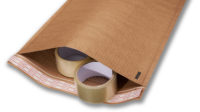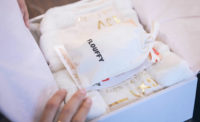The exponential growth of e-commerce, coupled with technological improvements in material options, is changing the way most companies are picking their protective packaging solutions.
Current focal points are performance/cost considerations driven by material improvements, e-commerce packaging needs, equipment/delivery systems that create packaging on demand, and sustainability pressures and alternatives to plastic.
Whether you are looking for cushioning, wrapping, blocking/bracing or void fill, there are new options and considerations that will impact your operation. Let’s take a look at each of these individually.
Material Improvements
For many years, the “poppable” bubble was the popular choice for wrapping products. However, shipping the bulky rolls to manufacturers took up a considerable amount of space, and the thin structure that made it so easy to pop individual cells also made those cells susceptible to failure.
A shift has occurred, however, with the evolution of both machinery capabilities and improvements in resin. Instead of making cushioning material from monolayer polyethylene (PE), it is now coextruded in five or more layers. New metallocene-based resins enable ultra-thin layers to be coextruded. This means that “sandwiches” of five or more layers are thinner than the monolayer PE alternative. The end result is improved strength using less material (gauges are under 1 mil, which is approximately 50 percent thinner).
Another aspect of the coextruded structure is that it lends itself well to the inclusion of recycled content resin in one or more layers as it becomes available. (It can even be buried in one of the interior layers for direct food contact applications.) In addition, the reduction in material use typically means improved cost.
Equipment/Delivery Systems
In addition to potential performance issues with air bubble rolls, they take up a lot of space on a truck and eat up inventory space. This has been one of the catalysts behind equipment innovation. The preferred approach is to create air cushioning on demand, right at the packing station.
The “inflated on demand” approach creates additional flexibility because fulfillment operations can choose the type of cushioning pattern that works best for a product. For example, varying sizes of air pillows can be created, as can hybrid cushioning or void fill. In the case of hybrid cushioning, different sizes/configurations of small, square “quilted” patterns can be produced to accommodate specific products and/or requirements.
Part of this solution oftentimes includes overhead delivery systems that house a small amount of premade air pillows or hybrid cushioning to ensure availability when the packer needs it and/or to feed multiple stations.
E-commerce Packaging Needs
Protective packaging solutions for the e-commerce sector can vary from simplistic to complicated and contradictory. On opposite ends of the spectrum is the need to package the product for damage-free transit to the consumer’s home, juxtaposed against growing consumer demand for a reduction in packaging materials and improvement in recyclability.
We also have CPG products entering e-commerce distribution that, up until recently, were purchased from retail shelves. So manufacturers are faced with a challenge: Do they use the same package for e-commerce fulfillment that they sell at retail or design a completely new primary package that is better suited for parcel shipping?
The path chosen will have significant bearing on the protective packaging selected. Take a bottle of shampoo, for example. Retail-ready bottles require a fair amount of resin to withstand top load during palletization and survive distribution in corrugated shippers. We also can’t forget the closure type, which creates another area that requires protection in the case of pumps.
Going with the retail-ready bottle for e-commerce is certainly the quickest way to go, but is it the best approach in the long run? Brand owners are going to have to study their specific product and various distribution channels to determine what makes the most sense to support the customer experience.
The Unboxing Experience
The unboxing experience has replaced the store shelf/shopping cart approach to shopping. For those ordering from an online retailer or distributor, oftentimes a first experience with the product will be when it arrives at the purchaser’s doorstep.
A recent study conducted by Pregis and the University of Wisconsin (UW) in Madison shows that the value perception of e-commerce shipments is significantly impacted by the materials chosen to protect them. In fact, a small increase in packaging material expenditures — as little as 19 cents — can make a dramatic impact (as much as 45 percent) on the perceived value.
The study included two groups of 30 participants each. Each group was asked to unbox the same product: a bamboo bowl with a retail price of $25. Participants didn’t know the cost of the bowl so that perception could be captured.
The two groups were presented with a box prepared with different packaging. One was described as ”economy” — a plain brown box with white polystyrene foam for inside protection was used, sealed with clear carton sealing tape. The other “premium” package held product in a white box with clear, inflated hybrid cushioning featuring a square pattern protecting the contents. A soft, white foam with a “thank you” sticker on it was wrapped around the bowl.
After unboxing, participants completed a survey that focused on expected price, likelihood to gift, unboxing emotions, packaging perception and the most likely retail outlet from which the package came. The premium packaging components scored higher across all attributes.
The study demonstrates that while the primary product package is important, the parcel packaging selected to translate the brand promise should be given equal consideration.
Sustainability Drivers
Savvy brand owners understand that one of the biggest issues facing the industry is the accumulation of waste if items are damaged (including item damage and packaging waste), as well as the additional greenhouse gas and fuel from the return shipping cycle.
The issue is compounded by the inability to collect and recycle plastic-based material for subsequent lifecycles. Take PET bottles for example. Although several major companies have committed to 100 percent reusable, recyclable or compostable packaging by 2025 or earlier, those efforts will be significantly impacted by material availability.
According to NAPCOR, the 2016 PET bottle recycling rate was 28.4 percent, which means that roughly three out of four PET bottles are never collected. The end result is only one in seven post-consumer bottles are reprocessed into next-generation rPET flake for use in new bottles.
Statistics are even more dismal for flexible materials, which is what a significant portion of protective package is made from.
There really isn’t one correct solution for all protective packaging situations. Brand owners, distributors and others need to work with their suppliers to do a careful pack analysis. All factors that contribute both to economics and damage minimization should be considered.
Pregis LLC is a customer-driven solutions provider of innovative protective packaging materials, equipment systems and surface protection. As a material neutral company, the company works with its customers to find the right solution to solve their business challenges. Pregis serves a wide variety of consumer and industrial market segments including food, pharmaceutical, medical devices, agricultural, e-commerce, retail, automotive, transportation, electronics and more.
Visit pregis.com for more information.





